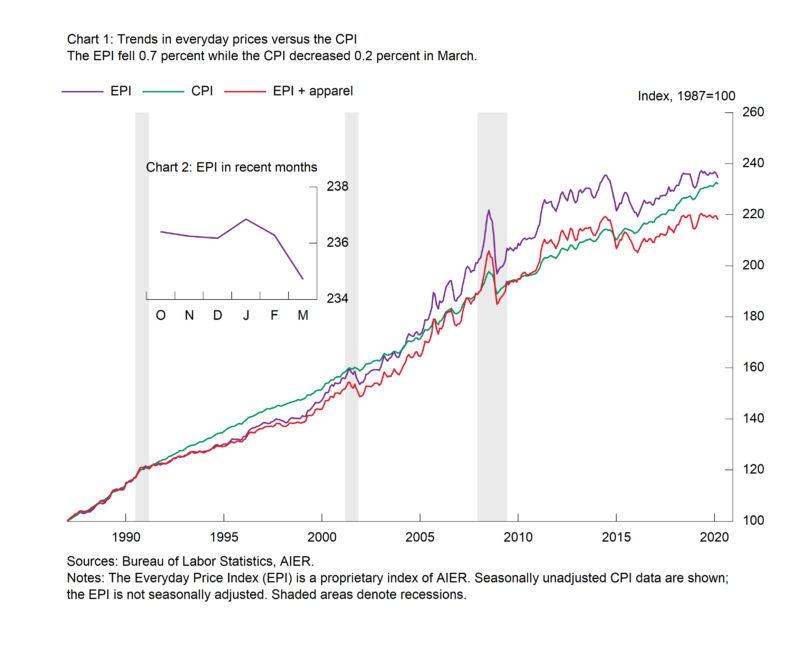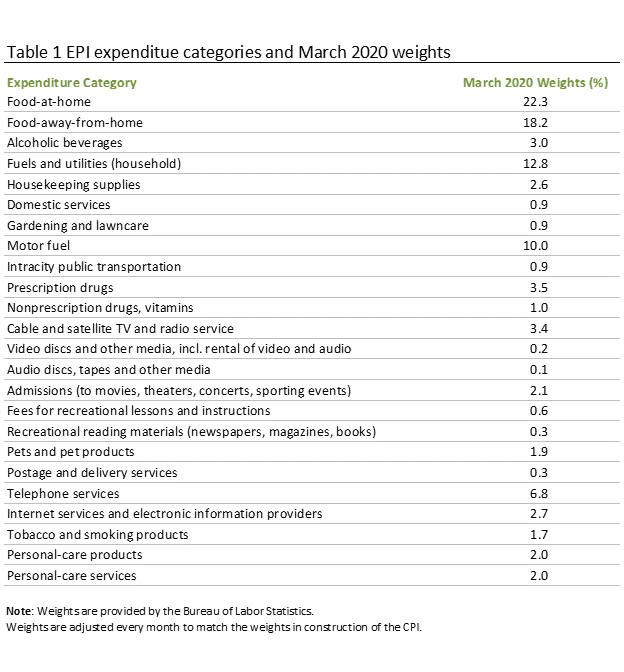Everyday Price Index Falls Amid COVID-19 Outbreak
Note: The Everyday Price Index for March is based on incomplete data. Thirteen of the 24 inputs into the index were unavailable due to restrictions on data collection by Bureau of Labor Statistics personnel because of the COVID-19 outbreak. The 13 categories account for 18.5 percent of the total index.
AIER’s Everyday Price Index fell 0.7 percent in March after posting a 0.2 percent decrease in February. The Everyday Price index has been flat or down in seven of the last ten months. Over the past year, the Everyday Price Index has risen 0.3 percent. The Everyday Price Index measures price changes people see in everyday purchases such as groceries, restaurant meals, gasoline, and utilities. It excludes prices of infrequently purchased, big-ticket items (such as cars, appliances, and furniture) and prices contractually fixed for prolonged periods (such as housing).
The Everyday Price Index including apparel, a broader measure that includes clothing and shoes, was down 0.6 percent in March after being unchanged in February. The Everyday Price Index including Apparel has been flat or down in six of the past ten months and is up 0.2 percent over the past year. Apparel prices fell 0.5 percent on a not-seasonally-adjusted basis in March and are down 1.6 percent over the past year. Apparel prices tend to be volatile, registering sporadic large gains or declines in between stretches of relatively steady prices.
The Consumer Price Index, which includes everyday purchases as well as infrequently purchased, big-ticket items and contractually fixed items, fell 0.2 percent on a not-seasonally-adjusted basis in March. The Everyday Price Index is not seasonally adjusted, so we compare it with the unadjusted Consumer Price Index. Over the past year, the Consumer Price Index is up 1.5 percent.
Motor fuel prices fell 7.4 percent for the month on a not-seasonally-adjusted basis. Over the past year, motor fuel prices are down 10.2 percent. Motor fuel prices are largely a function of crude oil prices. West Texas Intermediate crude oil prices fluctuated dramatically from mid-2017 through mid-2019, rising to a peak above $75 per barrel in October 2018 before plunging to less than $45 by December 2018, then recovering to around $65 by mid-2019. More recently, crude oil prices were drifting higher until early February, hitting a peak just above $63. Since early February, prices have plummeted to a low around $20 as the outbreak of COVID-19 and tensions among OPEC members have driven prices lower.
For the two major food components, grocery prices rose 0.5 percent in March but are up just 1.1 percent from a year ago while restaurant prices increased 0.2 percent for the month and are up a robust 3.0 percent over the past year. Over the last five years, grocery prices are essentially unchanged, rising at an annualized 0.3 percent while restaurant prices are up at an annual rate of 2.7 percent.
Other categories with significant increases over the past year include recreational reading materials (up 5.8 percent), tobacco and smoking products (up 5.4 percent), and personal care services (up 3.3 percent). These categories have relatively small weights in the Everyday Price Index.
Overall, changes in the Everyday Price Index have been flattening. Energy prices are the most volatile component and, given the plunge in crude oil prices recently, are a negative contributor. Grocery prices (food at home) have been rising at a slow pace but may show upward pressure as panic buying spreads. This trend stands in sharp contrast to restaurant prices (food away from home) which have been rising more quickly and persistently but may show declines in coming months as people shelter-in-place.








